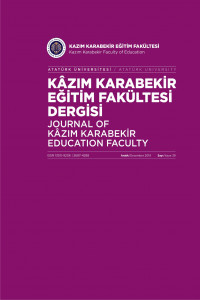Research Article
Aim & Scope
Atatürk University Journal of Kazım Karabekir Education Faculty is a peer-refereed journal that publishes original research articles, essays / reviews and translations on theory and practice in Educational Sciences and Teacher Training and contributing educational sciences. The journal is published twice a year (June and December).
The target audience of this journal is academics, educators, teachers, prospective teachers, students, administrators, and other educational staff.
Education Management, Education Supervision; Educational Philosophy , Educational History and Policies; Psychological Counseling and Guidance; Early Childhood Education, Preschool Education; Special Sducation; Adult Education; Vocational and Technical Education, Public Education, Lifelong Learning, Education Law, Education Economy, History of Education, Teaching Processes, Research Methods in Education, Testing and Assessment in Education; Educational Technology; Program Development and Evaluation in Education; Science Education; Mathematics Education, Chemistry Education, Biology Education, Physics Education, Fine Arts Education; Music Education, Art Work Education, Physical Education; Classroom Education, Social Studies Education; Turkish Education; Turkish Language and Literature Education, Philosophy Education, Geography Education, History Education, Foreign Language Education and Applied Linguistics
Author Guidelines
The article should not be less than 3000 words and not exceed 12000 words including title, Turkish abstract / English abstract, article text, summary in English, references, and appendix. Click here for Article Template.
NOTE: In line with our publication policy, valuable experts in this field are consulted to prevent plagiarism and the "IThenticate" program is used. The similarity ratio should be below 15%. While the article is uploaded to the system, the pdf file showing the similarity ratio must be uploaded with the full text, copyright declaration form and ethics committee document.
Title (Turkish): It must be centered, written in a size of 14 pt. Times New Roman font, bold and uppercase letters. The title should not exceed 15 words.
Title (English): It must be centered, written in a size of 12 pt. Times New Roman font, bold and uppercase letters. The title should not exceed 15 words.
Abstract (Turkish): Each article must involve Turkish and English abstract at the beginning. If the article is written in Turkish, Turkish abstract should be placed before English abstract. However, if the article is written in English, English abstract should be placed before Turkish abstract. The label of Abstract should be written in a size of 12 pt. Times New Roman font, and flush left. Abstract must involve aim, research method, sample or study group, data collection tools, findings, and results. Abstract should be written in a size of 10 pt., justified alignment, single-spaced, and not exceeding 150-200 words. It should not involve any citations.
Keywords: The number of Turkish keywords should be between 3 and 6.
Abstract: You need to insert an English abstract into this section by taking into account exactly the same format: aim, research method, sample, data collection tools, findings and results. The abstract should be written in a size of 10 pt., Times New Roman font, single-spaced, and not exceeding 150-200 words
Keywords: The number of English keywords should be between 3 and 6.
Article Text
The text should be written, in a size of 12 pt. Times New Roman font, single-spaced and as a single column leaving margins of 3.5 cm at the right and top, and margins of 2.5 cm at the left and bottom of every page. Each paragraph should involve at least three sentences.
The paragraphs should begin with a 1.25 cm-indent, and there should be no space among paragraphs.
The article should involve following parts “Introduction, Methodology, Findings, Discussion, Conclusion and Suggestion, References” respectively. Review articles should involve parts and subparts in line with the content.
Headings
Turkish title of the article should be centered, written in a size of 14 pt. Times New Roman font and bold. English title of the article should be centered and written in a size of 14 pt. Times New Roman. The title should not exceed 15 words. English title should be placed under Turkish title.
First level of heading should be centered, written in a size of 12 pt., bold, and uppercase letters.
e.g.:
INTRODUCTION
Two levels of heading should be flush left, written in a size of 12 pt., bold, and lowercase and uppercase letters.
e.g.:
Study Group
Three levels of heading should be flush left, italicized, written in a size of 12 pt., and lowercase and uppercase letters.
e.g.:
Scientific Process Skill Test
Four levels of heading should be flush left, with a 1.25 cm-indent, italicized, written in a size of 12 pt. Times New Roman font and uppercase and lowercase letters.
e.g.
Academic Achievement Test
Tables and Figures
Tables and figures should be ready for publication and given where they are cited in the text. Tables should be numbered consecutively such as “Table 1” and given titles. Table number should be writen above the table and the title should be flush left,.
Table 1.
Title of the Table Should Be Flush Left, the First Letters of Principal Words Capitalized and Italicized
Tables should not involve any vertical lines and should have just three horizontal lines. Table inside should be written in 10 pt and single-spaced. Similarly, figures should be numbered consecutively.
Titles, tables, figues, references and all other parts in submitted articles should be prepared according to APA 6th edition. If there is a table or figure from another source, it must cited. In addition, explanation for the tables and figures, if necessary, should be given below.
Figure captions should be below the figures and centered.
Figure 1. Experimental Design of the Study
Introduction: All text should be written in 12 pt, Times New Roman font and double-spaced. Introduction should involve research problem, studies in literature, rationale, significance, and purpose of the study, and research questions.
Method: This section should involve research method/design, population/sample/participants, data collection techniques and tools, data collection procedure, data analysis, and validity and reliability.
Findings: Findings of the study should be presented in tables or figures clearly and comprehensibly.
Discussions: Findings should be discussed in the light of the studies in literature.
Conclussion and Suggestions: The most important results arising from the study should be written. They can be itemized. Some suggestions based on the results of the study should be provided for further studies and practicians.
Reference List: References should be given according to APA 7th Edition.
Ethical Principles and Publication Policy
Atatürk University Journal of Kazım Karabekir Education Faculty undertakes to maintain high standards with strict ethical policies and its publication process dpends on production, development, and sharing of information through an objective and scientific way. A strict ethical process based on peer-review is adopted to publish the best research articles for academic and practical use. Violations of professional scientific ethical laws such as plagiarism, production and data tampering are taken very seriously without tolerance by editors. Therefore, authors should follow universally accepted scientific reporting principles.
Ethical Violation
In publication process, authors, readers, researchers, publishers, referees, and editors should follow general and speicific rules published by “Committee on Publication Ethics (COPE)” Also, the stakeholders are expected to avoid plagiarism, falsification, detortion, duplicated publication, salami slicing and all other ethical violation types mentioned under the title of CoHE Publication Ethics and Malpractice Statement.
In case of any ethical violation claim for any research paper submitted, editor and deputy editors will deal with the issue to the official publication rules and principles. In necessary cases, proofreading and editing can be requested from authors for their papers. For the cases that ethical violation is located, the concerned article is removed from journal web site.
The paper submitted should be original and should not be officially published in any other house organ. Besides, the paper should not be in peer reviewing process of any journal or conference and should not have been published before. Also, the paper should not violate any existing copyright or other third parties’ copyrights.
Authors are responsible for cooperating with the editor in order to edit any problem or impropriety in their paper they have detected. Responsible author should certainly declare that all other authors of the paper have viewed and verified the last version of the article and aggreed with submitting the article for publication. Besides, responsible author should declare that the required information about all the authors have been correctly provided.
The articles submitted to the journal should accurately share all the data obtained and provide all the details and references in a way that could let the study be replicated. The fanciful and distorted claims are against research ethics and unacceptable.
To the publication policy of the journal, in order to avert any plagiarism, the papers are offered to experts for consideration and “IThenticate” programme is used. The similarity percentage should be less than 15%.
In citation, academic language and rhetoric should be used. Proprietary and private information, obtained from a speech, a correspondence, or third parties, can not be used or delivered without any official written permisson by the source.
Our editorial board has started to ask for ethics commitee approval for all the studies in educational sciences from the begining of 2020. Authors should declare and document their ethics commitee approval in their article.
The relevant information about ethics commitee approval (commitee, date, and serial number) for the studies required for the commitee report should be given in methodology part and also on the first and last pages of the article. In case studies, authors also should declare that the protocols proving the voluntary participation of participants have been signed.
Besides, from the beginning of 2020, in polyonoumous articles, the contribution rate of each author should be stated; if the study was funded by any agenicies, institutes and organizastions, they should be declared in Acknowledgements. Also, if there is any Conflicts of Interest, authors should declare.
Peer Review Process
All articles are sent to experts in the field invited to review the papers. In this regard, in our journal, double blind review method is followed. All the articles are independently evaluated by two reviewers. Each reviewer makes decisions about papers in terms of either accept, or revision, or reject of the article. If one of the reviewer rejects and the other reviewer accepts the paper, then the article is sent to third reviewer and on the basis of his/her decision, the article is either accepted or rejected.
If reviewers request for revision, authors will revise their artciles to the points reviewers will have outlined. Rarely, the re-submitted articles may be sent to fourth reviewer for further evaluation. As soon as revisions are completed and editor accepts, the correspondent author will be informed about the accept of the article for publication. For rejected papers, the correpondent author is not contacted. Peer reviewing process is approximately 6 months. This process may extend or shorten to the feedback by the reviewers.
Price Policy
Dergimiz makale yayını için herhangi bir ücret talep etmemektedir.
Indexes
Citation Indexes
Journal Boards
Editorial Board
Ufuk ŞİMŞEK
Department of Social Studies Education, Atatürk University, Faculty of Kazım Karabekir Education, Erzurum, Turkey
E-Mail: ufuk@atauni.edu.tr
Editor in Chief
Ali Osman ENGİN
Department of Curriculum and Instruction, Atatürk University, Faculty of Kazım Karabekir Education, Erzurum, Turkey
ORCID: 0000-0002-3705-6548
E-Mail: aliosman.engin@atauni.edu.tr
Editors
Adnan TAŞGIN
Department of Curriculum and Instruction, Atatürk University, Faculty of Kazım Karabekir Education, Erzurum,Turkey
ORCID: 0000-0002-3704-861X
E-Mail: atasgin@atauni.edu.tr
Esra MİNDİVANLI AKDOĞAN
Department of Social Studies Education, Atatürk University, Faculty of Kazım Karabekir Education, Erzurum, Turkey
ORCID: 0000-0002-6508-3412
E-Mail: emindivanli@atauni.edu.tr
Seda OKUMUŞ
Department of Science Education, Atatürk University, Faculty of Kazım Karabekir Education, Erzurum, Turkey
ORCID: 0000-0001-6271-8278
E-Mail: seda.okumus@atauni.edu.tr
Foreign Language Editors
Merve GEÇİKLİ
Department of English Education, Atatürk University, Faculty of Kazım Karabekir Education, Erzurum, Turkey
ORCID:0000-0002-8619-5026
E-Mail: merve.gecikli@atauni.edu.tr
Mine YILDIZ
Department of English Education, Atatürk University, Faculty of Kazım Karabekir Education, Erzurum, Turkey
ORCID: 0000-0001-6215-4388
E-Mail: mine.yazici@atauni.edu.tr
Mülkiye Ezgi İSKENDER
Department of Turkish and Social Sciences Education, Atatürk University, Faculty of Kazım Karabekir Education, Erzurum, Turkey
ORCID: 0000-0003-1673-1345
E-Mail: ezgi.iskender@atauni.edu.tr
Nurullah AYDIN
Department of Turkish Education, Atatürk University, Faculty of Kazım Karabekir Education, Erzurum, Turkey
ORCID: 0000-0003-2522-7765
E-Mail: nurullah.aydin@atauni.edu.tr
Editorial Board
Ahmet AYIK
Department of Education Management, Atatürk University, Faculty of Kazım Karabekir Education, Erzurum, Turkey
E-Mail: ahmet.ayik@atauni.edu.tr
Alptürk AKÇÖLTEKİN
Department of Science Education,Çanakkale Onsekiz Mart University, Faculty of Education, Çanakkale, Turkey
E-Mail: alpturk.akcoltekin@comu.edu.tr
Alev ÇETİN DOĞAN
Department of Science Education, Gazi University, Faculty Education, Ankara, Turkey
E-Mail: alevd@gazi.edu.tr
Alper Cihan KONYALIOĞLU
Department of Mathematics Education, Atatürk University, Faculty of Kazım Karabekir Education, Erzurum, Turkey
E-Mail: ackonyali@atauni.edu.tr
Ataman KARAÇÖP
Department of Science Education, Kafkas University, Faculty of Dede Korkut Education, Kars, Turkey
E-Mail: ataman.karacop@gmail.com
Aylin MENTİŞ KÖKSOY
Department of Classroom Education, Ege University, Faculty Education, İzmir, Turkey
E-mail: aylinmentiskoksoy@gmail.com
Dursun DİLEK
Department of Social Studies Education, Sinop University, Faculty of Education, Sinop, Turkey
E-Mail: dursundilek@sinop.edu.tr
Eka Cahya PRIMA
Science Education, Indonesia University of Education, Bandung, Indonesia
E-mail: ekacahyaprima@upi.edu
Engin KURŞUN
Department of Computer and Instructional Technology Education, Atatürk University, Faculty of Kazım Karabekir Education, Erzurum, Turkey
E-mail: ekursun@atauni.edu.tr
Esther Nieto MORENO de DIEZMAS
Language Education, Castilla-La Mancha University, Ciudad Real, Spain
E-mail: Esther.Nieto@uclm.es
Halil TOKCAN
Department of Turkish and Social Sciences Education, Niğde Ömer Halisdemir University, Faculty of Education, Niğde, Turkey
E-mail: haliltocan@gmail.com
Hakan AKDAĞ
Department of Turkish and Social Sciences Education, Mersin University, Faculty of Education, Mersin, Turkey
E-mail: hakanakdag@mersin.edu.tr
Jon-Chao HONG
Game-Based Learning and Teaching, National Taiwan Normal University, Taiwan
E-mail: hong506@gmail.com
Kubilay YAZICI
Department of Social Studies Education, Niğde Ömer Halisdemir University, Faculty of Education, Niğde, Turkey
E-Mail: kyazici@ohu.edu.tr
Mehmet BAŞTÜRK
Department of Foreign Language Education, Balıkesir University, Necatibey Faculty of Education, Balıkesir, Turkey
E-Mail: basturk@balikesir.edu.tr
Mehmet Nuri GÖMLEKSİZ
Department of Education Science, Fırat University, Faculty of Education, Elazığ, Turkey
E-Mail: ngomleksiz@firat.edu.tr
Murat ÇALIŞOĞLU
Department of Social Science, Ağrı İbrahim Çeçen University, Faculty of Education, Ağrı, Turkey
E-Mail: mçalisoğlu@agri.edu.tr
Mustafa SÖZBİLİR
Deapartment of Mathematics and Science Education, Atatürk University, Faculty of Kazım Karabekir Education, Erzurum, Turkey
E-mail: sozbilir@atauni.edu.tr
Nilüfer OKUR AKÇAY
Department of Preschool Education, Ağrı İbrahim Çeçen University, Faculty of Education, Ağrı, Turkey
E-Mail: nilokur-7@hotmail.com
Oğuz DİLMAÇ
Department of Basic Art Education, İzmir Katip Çelebi University, Faculty of Art and Design, İzmir, Turkey
E-Mail: oguz.dilmac@ikcu.edu.tr
Osman SAMANCI
Department of Classroom Education, Atatürk University, Faculty of Kazım Karabekir Education, Erzurum, Turkey
E-Mail: osamanci@atauni.edu.tr
Ovidiu Florin CALTUN
Faculty of Physics, Alexandru Ioan Cuza University, Romania
E-mail: caltun@uaic.ro
Raşit ZENGİN
Department of Mathematics and Science Education, Fırat University, Faculty of Education, Elazığ, Turkey
E-Mail: rzengin@firat.edu.tr
Salih DOĞAN
Department of Biology, Erzincan Binali Yıldırım University, Faculty of Science Literature, Erzincan, Turkey
E-Mail: salihdogan@erzincan.edu.tr
Selahattin KAYMAKÇI
Department of Turkish and Social Sciences Education, Kastamonu University, Faculty of Education, Kastamonu, Turkey
E-mail: skaymakci@kastamonu.edu.tr
Selçuk KARAMAN
Department of Management Information Systems, Hacı Bayram Veli University, Faculty of Economics and Administrative Sciences, Ankara, Turkey
E-Mail: selcuk.karaman@hbv.edu.tr
Stefan RATHERT
Department of English Language Education, Kahramanmaraş Sütçü İmam University, Faculty of Education, Kahramanmaraş, Turkey
E-mail: strahert@gmail.com
Şükrü ADA
Department of Education Management, Bursa Uludağ University, Faculty of Education, Bursa, Turkey
E-Mail: sukruada@uludag.edu.tr
Ümit ŞİMŞEK
Department of Science Education, Atatürk University, Faculty of Kazım Karabekir Education, Erzurum, Turkey
E-Mail: simsekum@atauni.edu.tr
Yasin DOĞAN
Department of Turkish and Social Sciences Education, Pamukkale University, Faculty of Education, Denizli, Turkey
E-mail: yasind@pau.edu.tr
Zehra ÖZDİLEK
Department of Mathematics and Science Education, Bursa Uludağ University, Faculty of Education, Bursa, Turkey
E-mail: zozdilek@uludag.edu.tr



Dil Editörleri
Dr. Öğrt. Üyesi Merve GEÇİKLİ (İngilizce)
Dr. Öğrt. Üyesi Mine YILDIZ (İngilizce)
Arş. Gör. Dr. Nurullah AYDIN (Türkçe)
Arş. Gör. Mülkiye Ezgi İSKENDER (Türkçe)
Mizanpaj
Arş. Gör. Dilek TEKE
Arş. Gör. Yeter ÜNLÜ


